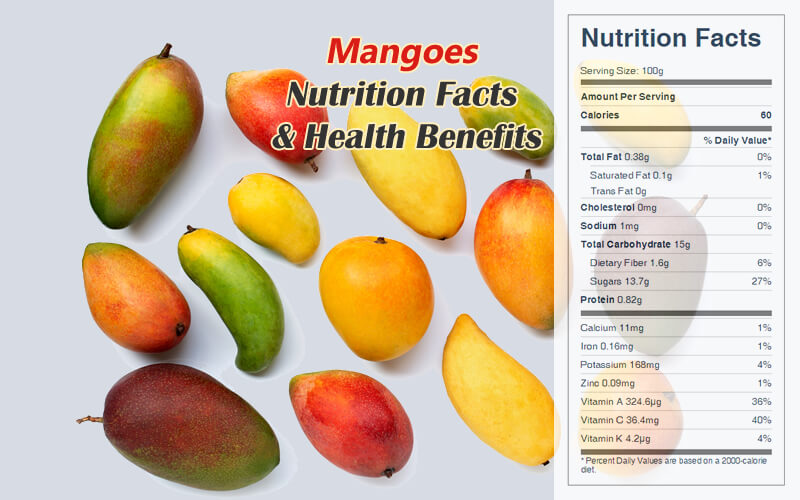Mangoes Nutrition Facts & Health Benefits
There are several hundred mango varieties worldwide. Mango fruit can be light yellow, gold, green, or orange depending on the varietal. Mangoes have many healing properties as they possess a unique phytochemical called mangiferin, which contributes to their anti-inflammatory and antioxidant potential. Here are the nutritional benefits of mangoes.

A raw mango is 84% water, 15% carbohydrates, 1% protein, and has negligible fat. The energy value per 100g serving of a raw mango is 250 kJ (60 calories). Fresh mango contains vitamin C and folate in significant amounts of the daily value as 44% and 11%.
Mangoes Nutrition Facts Label
Health Benefits of Mangoes
Mango is sweet and sour, with a cooling energy. It is rich in amino acids, beta-carotene, niacin, vitamins C and E, flavonoids, calcium, iron, magnesium, and potassium. Mango also contains pectin, which is useful in lowering blood cholesterol levels.
One mango provides over a day’s dose of vitamin C, two-thirds of the recommended amount of vitamin A, nearly half the recommended amount of vitamin E, and a quarter of your fiber, potassium, iron, and nicotinic acid for the day.
Phytochemical and nutrient content appear to vary across mango cultivars. Up to 25 different carotenoids have been isolated from mango pulp, the densest of which was beta-carotene, which accounts for the yellow-orange pigmentation of most mango cultivars. Mango leaves also have significant polyphenol content, including xanthonoids, mangiferin, and gallic acid. Mango pulp contains a variety of polyphenols that exhibit its antioxidant and anti-inflammatory benefits. Quercetin is one of the major glycosides found in mango pulp.
Numerous phytochemicals are present in mango peel and pulp, such as the triterpene lupeol. Mango peel pigments under study include carotenoids, such as the provitamin A compound, beta-carotene, lutein, and alpha-carotene; and polyphenols, such as quercetin, kaempferol, gallic acid, caffeic acid, catechins, and tannins. Mango contains a unique xanthonoid called mangiferin. Mangiferin has been shown to help balance the TH1/TH2 response.
Mangiferin possesses potent free radical scavenging ability, leading to its strong antioxidant effect, and mangiferin may have anticancer potential. This effect is related to its antiinflammatory and antioxidant abilities. Mangiferin has been demonstrated to be an effective inhibitor of the NF-kappa beta signaling pathways, thereby reducing inflammation.
Mangiferin is also responsible for the antioxidant properties of mangoes. It protects against oxidative stress by regulating the production of various transcription pathways responsible for inflammation (NLRP3 and Nrf2). The NLRP3 inflammasome turns on the innate immune system and releases proinflammatory cytokines. Mangiferin regulates these transcription factors and modulates the expression of the different pro-inflammatory cytokines that contribute to inflammation.
Mangoes stimulate an increase in short-chain fatty acids. This translates to an increase in bacterial fermentation, butyrate, the preferred food source for our gut epithelial cells. Mangoes have also been found to improve Bifidobacteria and Akkermansia levels in the gut.
Akkermansia is a probiotic that breaks down mucus in the gut and turns it into short-chain fatty acids. Scientists suspect it helps preserve the mucus that coats the walls of our intestines.
In addition to feeding our gut, mangoes can also play a role in gut anti-inflammatory effects and help to maintain the gut microflora. Its unique phytochemical mangiferin helps regulate our immune systems’ various processes and reduce inflammation. Imagine the benefits of eating raspberries and mangoes together: They are tasty, and when combined with the mangiferin fiber, have an effect on our gut bacteria and strengthen our gut wall.
In traditional medicine, its antiseptic twigs can be chewed to protect the teeth and gums. The bark is useful in treating diarrhea, while the fruit is given for high blood pressure.
Health Risk
Some people are allergic to mangoes, especially to the juice under the peel.
Contact with oils in mango leaves, stems, sap, and fruit skin can cause dermatitis and anaphylaxis in susceptible individuals.
Other mango compounds potentially responsible for dermatitis or allergic reactions include mangiferin. Sensitized individuals may not be able to safely eat peeled mangos or drink mango juice.
When mango trees are flowering in spring, local people with allergies may experience breathing difficulty, itching of the eyes, or facial swelling, even before flower pollen becomes airborne.
The skin of unripe, pickled, or cooked mango can be eaten, but it has the potential to cause contact dermatitis of the lips, gingiva, or tongue in susceptible people.